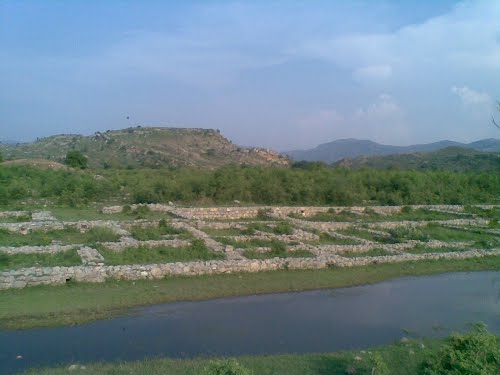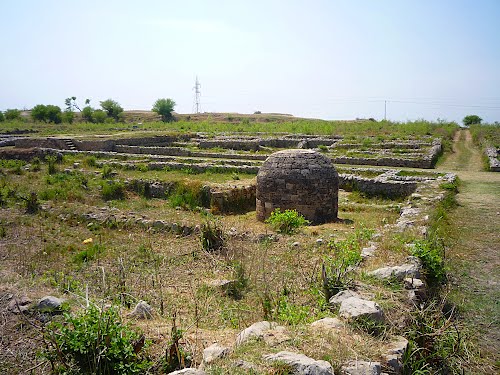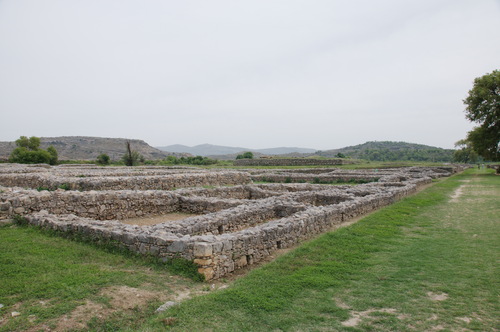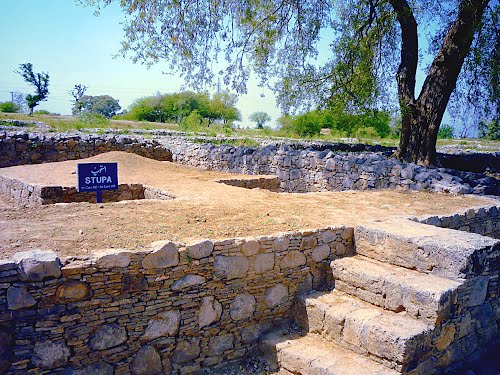Sirkap is the name of an archaeological site on the bank opposite to the city of Taxila, Punjab, Pakistan.
The city of Sirkap was built by the Greco-Bactrian king Demetrius and his son Stultus. after he invaded ancient India around 180 BC. Demetrius founded in the northern and northwestern modern Pakistan an Indo-Greek kingdom that was to last until around 10 BC. Sirkap is also said to have been rebuilt by king Menander I.
The excavation of the old city was carried out under the supervision of Sir John Marshall by Hergrew from 1912-1930. In 1944 and 1945 further parts were excavated by Mortimer Wheeler and his colleagues.
Greek city
The site of Sirkap was built according to the "Hippodamian" grid-plan characteristic of Greek cities. It is organized around one main avenue and fifteen perpendicular streets, covering a surface of around 1200x400 meters, with a surrounding wall 5–7 meters wide and 4.8 kilometers long. The ruins are Greek in character, similar to those of Olynthus in Macedonia.
Numerous Hellenistic artifacts have been found, in particular coins of Greco-Bactrian kings and stone palettes representing Greek mythological scenes. Some of them are purely Hellenistic, others indicate an evolution of the Greco-Bactrian styles found at Ai-Khanoum towards more indianized styles. For example, accessories such as Indian ankle bracelets can be found on some representations of Greek mythological figures such as Artemis.
Following its construction by the Greeks, the city was further rebuilt during the incursions of the Indo-Scythians, and later by the Indo-Parthians after an earthquake in 30 AD. Gondophares, the first king of the Indo-Parthian Kingdom, built parts of the city including the double headed eagle stupa and the temple of the sun god. The city was overtaken by the Kushan kings who abandoned it and built a new city at Sirsukh, about 1.5 km to the north-east.
Religious buildings
Buddhist stupas with strong Hellenistic decorative elements can be found throughout the Sirkap site, a Jain temple, as well as a Hindu temple, indicating a close interaction of religious cultures. A Greek religious temple of the Ionic order is also visible at the nearby site of Jandial, but there is a possibility that it may have been dedicated to a Zoroastrian cult.
The site of Sirkap bears witness to the city-building activity of the Indo-Greeks during their occupation of the Indian territory for close to two centuries, as well as their integration of other faiths, especially Buddhism.
Round stupa
One round Stupa is present at Sirkap. It is one of the oldest Stupas in the Indian-Subcontinent. It is assumed that this Stupa was uprooted and thrown to its present location by a strong earthquake in the 1st century AD. When the new city was built later, the Stupa was kept by building a protecting wall around it.
Apsidal Temple
The building that is known as the Apsidal Temple is the largest sanctuary of Sirkap, measuring about 70 by 40 meters. The Apsidal Temple consists of a square nave with several rooms, used by the Buddhist monks, and a circular room, which gives the building its apsidal shape. After the earthquake that destroyed the city in c. 30 AD, the Buddhist shrine was built in a spacious courtyard. The round part was probably in use for a small stupa, but no traces of it remain. Some carvings were probably done by an artist from Greece.
Double-Headed Eagle Stupa
A special Stupa at Sirkap is the so-called 'Double-Headed Eagle Stupa'. The pilasters here are of a Greek design, "Corinthian columns". In the middle arch, a Greek temple is shown; in the outer, a shrine of a Hindu design can be seen. On top of these sanctuaries, a Double-headed eagle is seated from which the name of the Stupa has been derived. This motive is rather odd, to say the least, as it is originally Babylonian. It seems to have spread to Scythia, and introduced in the Punjab by the Saka rulers.















